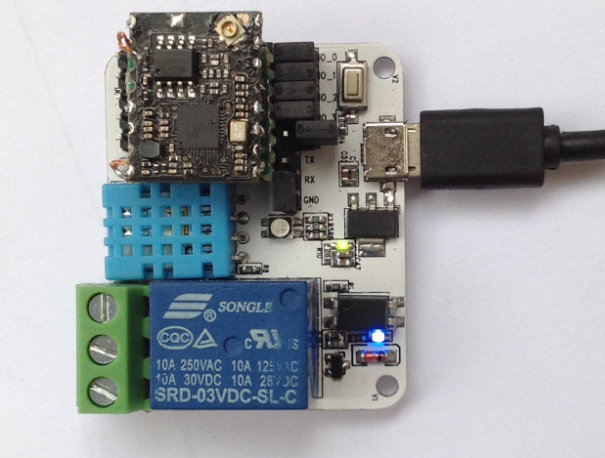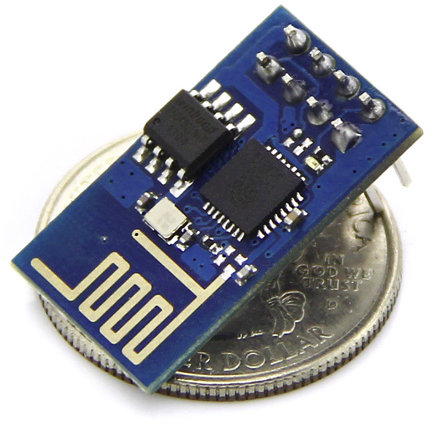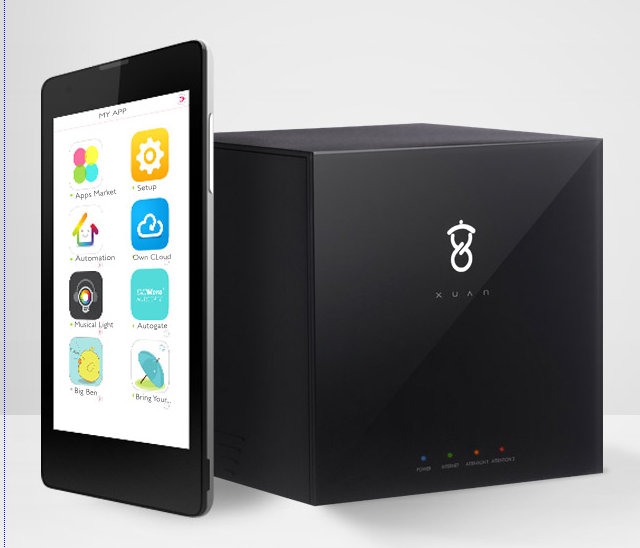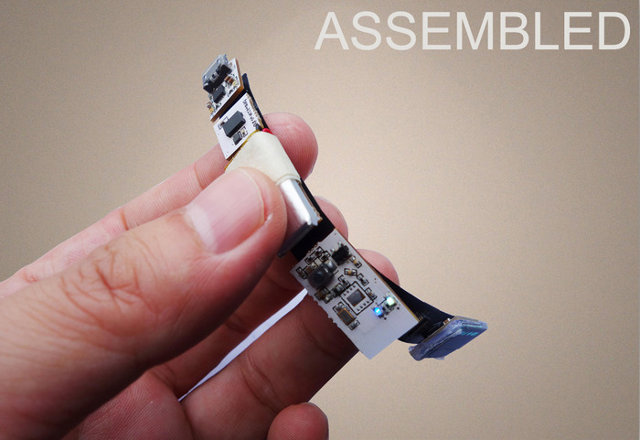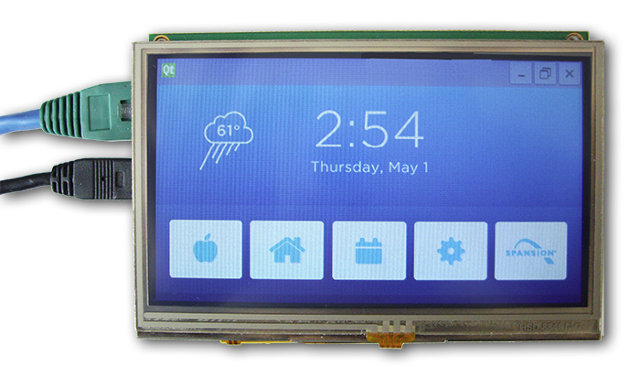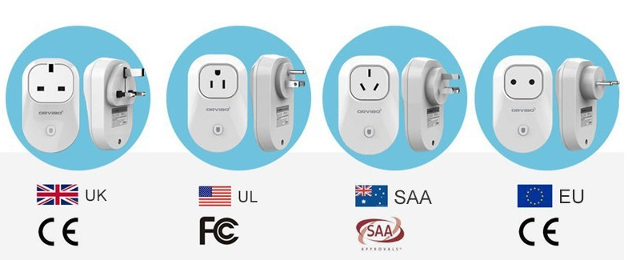For some reasons, Wi-Fi modules are pretty popular this year. After modules such as VoCore, AsiaRF AWM002, and ESP8266, here’s come xWifi. This module is based on Mediatek MT7681 SoC which includes a TCP/IP stack like Espressif ESP8622 or TI CC3300, so it won’t run OpenWRT like VoCore or AsiaRF modules. The module only consumes about 350mW during transfer, it will be open source hardware, and the xWifi module plus a dock with a 10A relay, a humidity and temperature sensor, and a LED will go for as low as $17. xWifi module only specifications: SoC – Mediatek MT7681 802.11 b/g/n SoC with 32-bit RISC CPU. Support for Client/softAP mode. Package size 5×5 mm Storage – 512KB SPI Flash (for firmware) I/Os via headers: UART and SPI interfaces. 5x GPIOs PWM Power – 3.3V, GND Power Consumption – ~70mA @ 5V (during RX active) Dimensions – 14 x 17 mm The […]
ESP8266 WiFi Serial Module Costs Just $5
Wi-Fi is great because it’s ubiquitous, and rather fast for a wireless standard. However, it drains batteries fast, and Wi-Fi modules are usually much more expensive than Bluetooth modules for instance. There’s not much that can be done with regards to power consumption, but thanks to ESP8266 module, it’s now feasible to add Wi-Fi to your Arduino board, or others, for just $5 including shipping on Aliexpress, but SeeedStudio also have it for $6.95. If you buy 1,000 pieces, it goes down to about $3 per unit. As reported by Hackaday, this module embeds ESP8266 SoC which takes care off all IP stacks, a bit like Texas Instruments CC3000 SoC, but it’s just much cheaper. Here are some of the specifications of the module (and processor): SoC – Espressif Systems ESP8266 32-bit RISC processor with 802.11 b/g/n support(32-pin QFN package), Interfaces: SDIO 2.0, SPI, UART, I2S Wi-Fi – 802.112 b/g/n […]
$25 GL.iNet 6416A is an Hackable OpenWRT Router with Easy UART and GPIO Access
There are plenty of low cost routers supporting OpenWRT, but GL.iNet 6416A has several advantages compared to devices like TP-Link WR703N. Both are based on Atheros AR9931, but GL.iNet router has more memory and storage (64MB RAM + 16MB Flash vs 32MB RAM + 4MB Flash), two Ethernet ports instead of just one, and 6 GPIOs, the serial pins, and power signals (5V, 3.3V and GND) are all easily accessible via though holes or headers. Gl.iNet 6416A can be purchased for about $25 on DealExtreme or Amazon US, and it used to be listed on eBay, but is now out of stock. Gl/iNET 6416A specifications: Wi-Fi SoC – Atheros AR9331 MIPS processor @ 400 MHz System Memory – 64MB RAM Storage – 16MB Flash Connectivity – 2x 10/100 Mbit Ethernet ports, 802.11 b/g/n Wi-FI up to 150Mbps USB – 1x USB 2.0 port, 1x micro USB port for power Debugging […]
Embedded Linux Conference Europe 2014 Schedule – IoT, ARM vs x86, Optimization, Power Management, Debugging…
The Embedded Linux Conference Europe (ELC 2014), CloudOpen, and LinuxCon Europe will jointly take place at the Congress Centre Düsseldorf, in Germany on October 13 – 15, 2014. The 3-day events will consists of keynotes, presentations, and tutorials. Each day will open with two or three keynotes by speakers including Jim Zemlin (Executive Director, Linux Foundation), and Jono Bacon (XPRIZE), followed by presentation and tutorials. There will be 45 presentations for ELCE, 58 for LinuxCon, and 47 for CloudOpen, I’ll make a virtual schedule with a few sessions part of the Embedded Linux Conference Europe “track”. Monday, October 13 11:15 – 12:05 – Performance Analysis Using the Perf Suite by Mans Rullgar, Consultant When faced with a performance problem, the initial steps towards a solution include identifying the sections of code responsible and the precise reasons they are time-consuming. To this end, the ‘perf’ profiling tools provide valuable insight into the […]
$79 STACK Box Home Automation / IoT Gateway Supports Wi-Fi, Ethernet, BLE, XBee, X10, Z-Wave and More (Crowdfunding)
Cloud Media (Syabas) is better known for their Linux based “Popcorn Hour” media players, and last year I reviewed their FreeOTT streaming media player powered by a Cavium ARM11 processor. The company is now entering the home automation market with the STACK Box (aka XuanBox) also powered by a Cavium ARM11 processor, and supporting various connectivity options to interface with popular smart “things” such as Belkin Wemo and Philips Hue, as well as a Raspberry Pi Bus (26-pin header) to support add-ons. STACK Box specifications: Processor – Cavium ARM11 processor @ 640 MHz (possibly Cavium CELESTIAL CNC1800L. TBC) System Memory – 256MB DDR3 Storage – 512 MB flash + SD card slot Connectivity 10/100M Ethernet Wi-Fi 802.11n with WPS Bluetooth LE 4.0 (included) Z-Wave (included) Dust Networks (extra module required) XBee (extra module required) X10 (extra module required) Insteon (extra module required) RF433/315 (coming soon) EnOcean (coming soon) ZigBee(coming soon) DCLink(coming […]
Vigekwear is a Modularized, Open source, Wearable BLE Development Kit (Crowdfunding)
[Update: Atomwear has been renamed to Vigekwear due to (Intel’s) copyrights infringement]. Giayee is a company mainly manufacturing Android tablets, thin clients, and mini PCs, but their latest product, called Atomwear, is a Bluetooth Low Energy (BLE) development kit based on Nordic nRF51822 chipset that comes with various modules such as battery charger, accelerometer, gyroscope, OLED display, heart rate monitor, etc… which connect together via 24-pin connector on a standard rigid baseboard or a flexible printed circuit (FPC). All modules are connected via the same 24-pin connector with power, I2C, SPI, UART, ADC, and GPIOs signals. The baseboard and FPC both contain 6 such connectors connected in parallel for up to 6 modules, and two baseboard can be connected together via a bridge circuit to accept more modules. The minimum configuration is with a BLE MCU module, and a power module. The different boards and modules are listed as follows: […]
Emcraft Systems Introduces IoT Devkit with LCD Display Powered by Freescale Vybrid VF6 SoC
Emcraft Systems has launched a IoT development kit based on on their Freescale Vybrid VF6 SoM featuring MVF61 SoC with a Cortex A5 MPU and a Cortex M4 MCU, and connected to a baseboard (IOT-BSB-EXT) with various connectors (USB, Ethernet, …) as well as a 4.3″ LCD (480×272 resolution) with touchscreen. The kit targets IoT gateway applications where a GUI (Graphical User Interface) and/or HMI (Human Machine Interface) are required. Vybrid IoT devkit specifications: SoC/Memory/Storage – Via Vybrid VF6 SoM with Freescale MVF61NN151CMK50 (No Security), or Freescale MVF61NS151CMK50 (with Security), 128 MB DDR3, Up to 512 MB NAND Flash, and 32 MBytes dual QSPI Flash Storage on Baseboard – micro SD card slot Display – 4.3″ 480×272 LCD with touch panel connected to the back side of the baseboard. Connectivity – 10/100M Ethernet USB – 2x micro USB OTG ports, 1x micro USB for debugging and/or power Debugging – 20-pin […]
Orvibo Wiwo S20 Wi-Fi Smart Socket Features US, EU, UK, or AU Plug Types
I’ve previously covered several Chinese Wi-Fi smart sockets including Broadlink SP2 also supporting power monitoring, and Kankun KK-SP3, a cheaper, more basic version that can only be turned on and off manually or via timers, and which runs OpenWRT. These plugs have one thing in common: they only come with Australian/Chinese plugs, so if you want to use them in Europe, the US, or United Kingdom, you’ll need an adapter, which may not the the safest things to do, and it’s also inconvenient. Orvibo Wiwo S20 is another model that appears to have the capabilities and a price similar to Broadlink SP2, but available in four flavors with US, EU, UK, and AU plug types. Orvibo Wiwo S20 is made of fireproof ABS, and is significantly smaller than Broadlink SP2, but the rest of the specifications are very similar: Material – ABC 94V-0 (fireproof) Wi-Fi 802.11 b/g/n Security – WEP, […]


